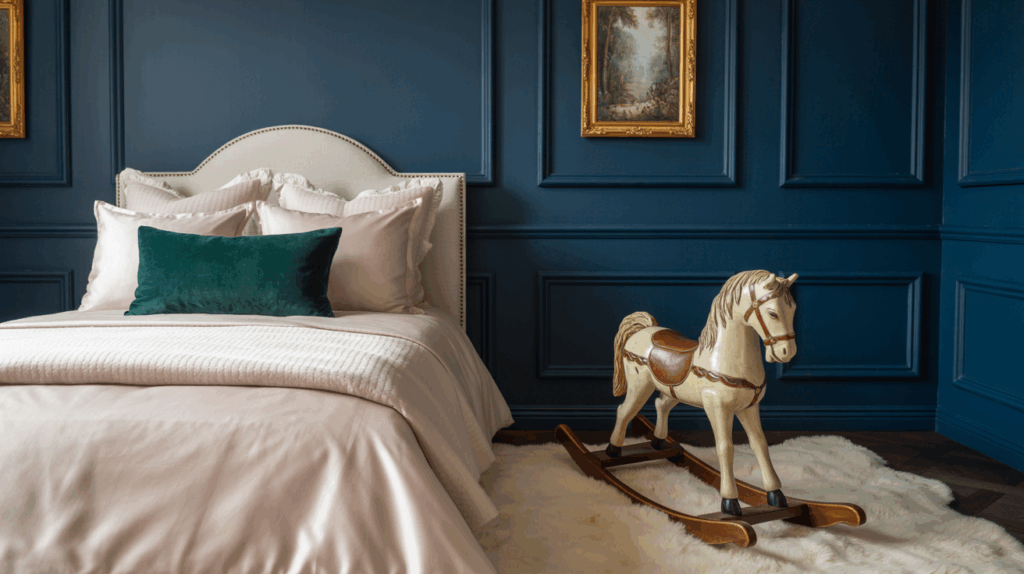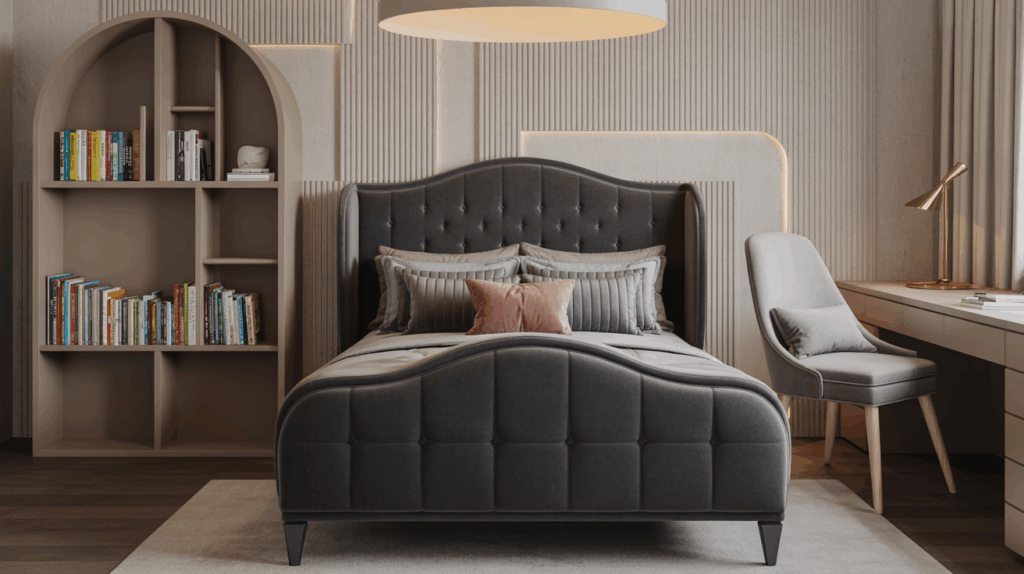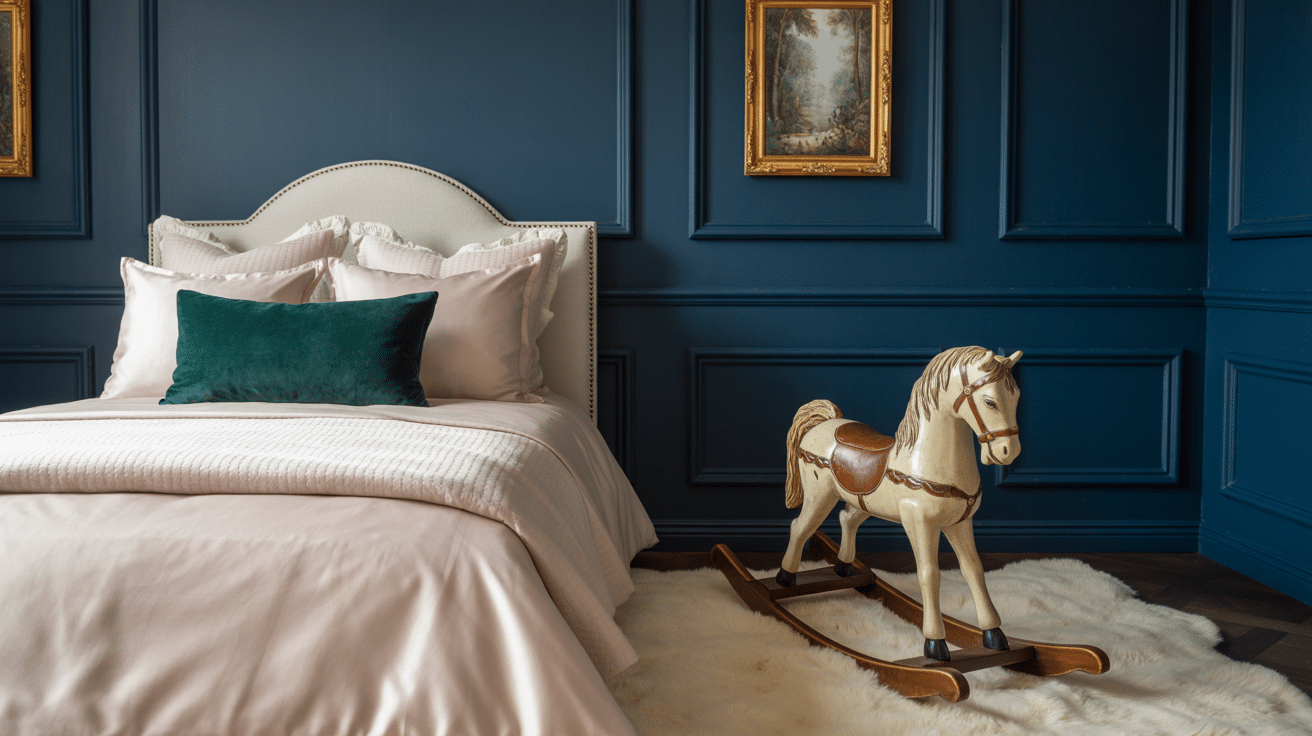Luxury Kids Bedroom with Dark Accents for a Moody Twist
Table of Contents
Rethinking children’s spaces with a modern, moody edge
Gone are the days when children’s rooms had to be all pastels, cartoon prints, and bright primaries. Today’s luxury kids bedrooms are embracing deeper tones, tactile richness, and refined palettes—proving that moody can still be magical. Parents and designers alike are discovering that rich charcoal, navy, forest green, and deep plum tones can create cozy, dramatic, and incredibly stylish environments for little ones.
The key to designing a luxury kids bedroom with dark accents lies in balance. By blending darker hues with soft textures, creative lighting, and playful details, you can build a space that feels high-end without sacrificing the warmth and imagination a child’s room needs. These designs also grow well with your child, offering timeless sophistication that avoids the need for constant updates.
In this guide, we’ll explore how to craft a moody yet luxurious bedroom for children—from choosing the right color combinations to layering decor, incorporating texture, and creating functional zones for sleep, play, and study. Whether you’re designing for a toddler or tween, you’ll find inspiration that feels elevated and uniquely personal.
Choosing the Right Dark Color Palette for a Kid-Friendly Mood
Dark tones don’t need to be heavy or somber—in fact, they can be deeply comforting and inspiring for kids. The trick is selecting shades that offer richness without overwhelming the space.
Start with one dominant dark tone, like navy, charcoal, or hunter green. Then build in neutrals (think cream, tan, dusty gray) and one or two accent colors—like muted gold, blush, or terracotta—to keep the room from feeling flat. Paint can be used strategically: go bold with a feature wall behind the bed or opt for dark wainscoting beneath a lighter shade for balance.
Wallpaper is another great way to introduce dark tones, especially those with whimsical or geometric patterns. Choose designs that offer subtle detail like stars, florals, or abstract shapes to keep things playful.
Color Palette Planning Table:
| Main Dark Shade | Complementary Neutrals | Accent Colors |
| Navy Blue | Soft beige, off-white | Gold, dusty rose |
| Charcoal Gray | Warm white, greige | Burnt orange, pale yellow |
| Forest Green | Cream, taupe | Brass, terra cotta |

Balancing Dark Tones with Soft Textures and Cozy Layers
To keep a dark-accented kids room from feeling too serious, texture becomes your best friend. Soft furnishings like velvet, cotton, faux fur, and boucle not only add warmth but also visual softness to contrast with moody walls and furnishings.
Begin with bedding—layer plush duvets, quilts, and textured throw pillows in complementary shades. Rugs also play a huge role. A soft, shaggy area rug or a patterned woven design adds grounding and comfort, especially if the room has hard flooring.
Window treatments, like linen blackout curtains in a neutral or accent color, help control light while adding another tactile layer. Add softness vertically with upholstered headboards or canopies above the bed—these make for cozy reading or sleeping nooks.
Texture Pairing Ideas:
| Texture Element | Recommended Material | Visual Impact |
| Bedding | Velvet, muslin, jersey | Softens bold wall tones |
| Rugs | Wool, shag, cotton blend | Adds grounding warmth |
| Curtains | Linen, gauze | Filters light with elegance |
| Seating or Canopy | Boucle, corduroy | Creates visual and tactile contrast |

Smart Furniture Selections with a Luxe Yet Practical Feel
Luxury in a child’s room is all about choosing furniture that feels thoughtful, durable, and elevated. Look for pieces that combine clean lines with warmth—think wood tones, matte finishes, and subtle metallic hardware.
The bed should serve as a strong design anchor. Upholstered bed frames in rich hues like navy or charcoal add softness and style. Opt for storage beds or those with under-bed drawers to reduce clutter. A sleek desk with brass handles or a bookshelf with arched openings adds sophistication and function.
Balance dark furniture with lighter wood finishes or soft-toned upholstery to avoid a heavy look. If you’re blending new and old pieces, unify them with cohesive finishes or matching hardware.
Luxury Furniture Elements Table:
| Piece | Design Feature | Style Tip |
| Upholstered Bed | Tufted or channel-stitched | Choose velvet or faux suede in dark tone |
| Nightstand | Brass accents, wood grain detail | Top with a soft-glow lamp or books |
| Bookshelf | Arched or open style | Paint interior backing for contrast |
| Desk & Chair Set | Sleek legs, comfy cushioned seat | Use dark-stained wood with soft leather |

Lighting Design That Softens the Mood and Enhances Function
Lighting plays a crucial role in making a dark-accented kids room feel luxurious and inviting. Too little lighting makes the room feel cave-like; too much, and you lose the moody charm. The solution is layers.
Start with a statement ceiling fixture—perhaps a fabric drum shade, rattan pendant, or star-shaped chandelier in brass. Then add task lighting for desks and nightstands. Wall-mounted sconces can be both practical and decorative, especially if space is tight.
Most importantly, include warm, ambient light sources. Salt lamps, string lights, or soft LED strips around bookshelves or under beds give off a calming glow—perfect for winding down at bedtime.
Lighting Layers Guide:
| Lighting Type | Purpose | Placement Tip |
| Overhead Fixture | Primary room light | Choose matte or fabric finish for softness |
| Table Lamp or Sconce | Reading and task lighting | Place near bed or desk |
| Ambient Lighting | Mood-setting and calming | Use dimmable or color-tuned options |
Designing Playful and Functional Zones within the Room
Even the most luxurious kids rooms need to serve practical, child-centered functions. Creating clear zones for sleep, play, and study ensures that the room remains functional as your child grows.
Use area rugs to visually separate spaces—for example, a patterned rug under a play tent or reading nook signals a playful zone. Built-in bookshelves or a cozy canopy corner can define a reading area, while a small table with chairs doubles as an art station or snack zone.
When space allows, try positioning furniture to create “rooms within the room.” A tall bookshelf or curtain panel can divide sleep from study areas. This helps keep the bed a restful retreat while still allowing for creativity and movement.
Functional Zoning Table:
| Zone Type | Key Pieces | Design Consideration |
| Sleep | Bed, nightstand, blackout curtains | Keep tones soft and warm |
| Study | Desk, task lamp, pinboard | Position near natural light if possible |
| Play or Reading | Tent, bookshelves, floor cushions | Include low seating and cozy textures |
Conclusion
A luxury kids bedroom with dark accents brings together elegance, personality, and comfort in one carefully curated space. By choosing moody tones with purpose, balancing them with soft textures, and incorporating functional elements that support your child’s daily routine, you craft an environment that is both stylish and child-centered.
These rooms feel modern and fresh, but also warm and nurturing—a reflection of thoughtful design and a willingness to go beyond the expected. Whether you’re redesigning from scratch or updating with a few bold touches, a moody twist may be the perfect way to create a space your child loves to grow in.

